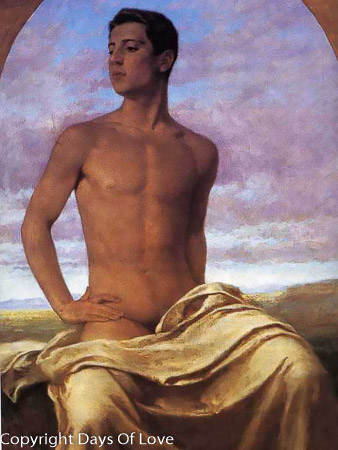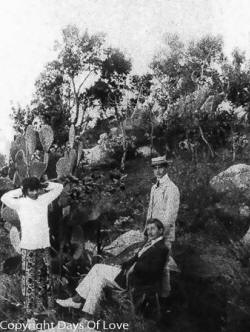

Partner Jacques d'Adelswärd-Fersen
Queer Places:
Villa Lysis, 80076 Capri NA, Italia
24 Rue Eugène Manuel, 75116 Paris
Campo Verano, Piazzale del Verano, 1, 00185 Roma, Italy
 Antonio
Cesarini (September 30, 1889 – October 25, 1943), better known by the
diminutive name Nino, was a model for several artists, such as the
photographer
Wilhelm von Plüschow, painters
Paul Hoecker and Umberto
Brunelleschi and sculptor Francesco Jerace during his youth. A fictional
character in Vestal Fire by
Compton Mackenzie. In his
adulthood he modelled for Vincenzo Gemito, who presented him as a
prototype of homoerotic masculine beauty. He was also known for his
relationship with baron
Jacques d'Adelswärd-Fersen. His life was novelized by the French
writer
Roger Peyrefitte in his work The Exile of Capri (L'exilé de
Capri) in 1959.
Antonio
Cesarini (September 30, 1889 – October 25, 1943), better known by the
diminutive name Nino, was a model for several artists, such as the
photographer
Wilhelm von Plüschow, painters
Paul Hoecker and Umberto
Brunelleschi and sculptor Francesco Jerace during his youth. A fictional
character in Vestal Fire by
Compton Mackenzie. In his
adulthood he modelled for Vincenzo Gemito, who presented him as a
prototype of homoerotic masculine beauty. He was also known for his
relationship with baron
Jacques d'Adelswärd-Fersen. His life was novelized by the French
writer
Roger Peyrefitte in his work The Exile of Capri (L'exilé de
Capri) in 1959.
Nino Cesarini was born into a working-class family in 1889. According to Peyreffite, Jacques d'Adelswärd-Fersen, who had been forced to leave Paris after a homosexual scandal, met him in Rome on July 9, 1904, when Nino was a fourteen-year-old construction worker and newspaper-seller. Fersen obtained authorization from the boy's family to take Nino as his secretary with him to Capri.[1] They lived together in Villa Lysis. In order to immortalize his beauty, the baron commissioned several artists to depict Nino. One of them was Umberto Brunelleschi, an Italian painter; another was the German painter Paul Hoecker, also exiled in Italy for the same (sexual) motives as those of Fersen. Finally, Fersen commissioned the famous sculptor Francesco Jerace to cast a statue of Nino in bronze, and placed it in the garden of the villa towards the sea. It was also repeatedly photographed by Wilhelm von Plüschow, dressed as a Roman emperor and as a Christian saint. Copies of these photographs were widely circulated and it is possible that even Adelswärd-Fersen sold them commercially. The only image of the Nino's statue by Jerace is von Plüschow's photograph.
In 1907 Fersen dedicated his work "Une Jeunesse / Les Baiser de Narcisse" to Nino, with the following phrase: "Dedicated to N. C. More beautiful than the light of Rome."
Nino's beauty made him attractive to other people. During the visit to Venice, he flirted with Alexandrine (Sacha) Ricoy Antokolsky, the daughter of the sculptor Mark Antokolsky, who even travelled back to Capri and finally managed to seduce him. Fersen reacted furiously with a volume of poems appropriately titled "So sang Marsyas" – an exalted song of praise for Nino, since he was frightened by the thought that Nino would abandon him. This explosion of passion can only be understood from the idea of Jacques' fear of losing the young man, and the jealousy that fuelled this fear, of something that would never happen.[2]

An Italian poet and writer Ada Negri, who had visited the villa, published an article in 1923 in the newspaper L'Ambrosiano, , shortly after the death of the baron, describing Nino with the following words: "The Villa was a place where everything was very beautiful, including Nino, the secretary, with the intense gaze of deep black eyes, crowned by well-shaped eyebrows." At that time, Jacques d'Adelswärd-Fersen, Nino's protector and lover, was in a phase of great dependence on opium, a drug that he smoked more than thirty pipes a day. According to Peyrefitte he had built a special smoking room in Villa Lysis, called the China Room.[3]
Will H. L. Ogrinc supposes in his work that as Nino grew up, the Baron d'Adelswärd-Fersen sought relationships with other young boys. As proof of this he uses Plüschow's famous photograph in which a naked young man is seen lying on a sofa in the interior of Villa Lysis, on one of whose walls the famous painting that Höcker painted to exalt the beauty of Nino can be seen. According to him, the naked boy on the couch is not Nino, since he seems too young in comparison to the subject of the painting.
NiNino and Adelswärd-Fersen travelled, at least a few times, to countries in the Far East. Apart from some temporary separations, for example during Nino's military service and his participation in the First World War, which was followed by a convalescence in the hospital due to the injuries he sustained there, Cesarini remained his entire life with the baron despite the fact that, over time, passion was replaced by friendship. According to Roger Peyrefitte, when he returned from the hospital he remained with Fersen only as a friend and secretary, and the baron's attempts to continue the sexual relationship were rejected by the then-mature Nino. Ogrinc in his turn, asserts that this statement of Peyrefitte, apart from not being documented, does not seem realistic, given the preference shown by Fersen for younger boys.
Baron Jacques d'Adelswärd-Fersen died in 1923 of an overdose of cocaine dissolved in a glass of champagne. There are indications that it may have been suicide, although there has been no unanimity in that explanation. Dr. Gatti, the doctor who signed the death certificate, established a heart attack as the cause of death, which was not consistent with an overdose of cocaine.[4]
Trying to protect the inheritance, the baron's family spread the rumour that he had been poisoned by Nino, driven by jealousy at the last relationship that Fersen maintained with the Corrado Annicelli. Baron's sister and mother insisted on an autopsy. The Naples authorities decided to carry it out, after which they dismissed such accusations.
AcAccording to the wishes of the late d'Adelswärd-Fersen, Nino received 300,000 francs and the right to the usufruct of the Villa Lysis. He later sold his rights to the Villa to Fersen's sister for 200,000 lire. His portrait painted by Brunelleschi and the statue of Jerace were, in turn, sold to a Swiss antiquary, and have since disappeared.
According to the most widespread version of events, Nino returned to Rome where he established a newsstand and bar. Nino died in October 1943 at age 54, and was buried in the Roman cemetery of Campo Verano. However, other sources claim that after the sale of his rights to the Villa, together with the inheritance he received, Nino was rich enough to retire, as well as cultured and refined (he apparently spoke several languages), which makes it difficult to understand why he decided to sell newspapers in a kiosk. According to this other version, he died of an opium overdose. After his death, his family destroyed all the letters of Baron d'Adelswärd, many of his photos and a collection of erotic objects.
My published books: